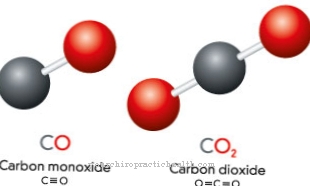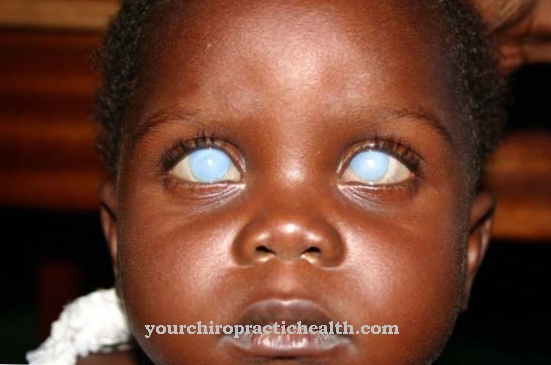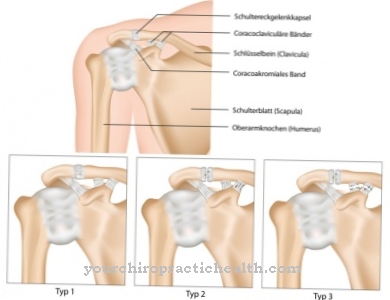The hemorrhagic fever is a very dangerous disease for humans that occurs mostly in subtropical to tropical areas. Nevertheless, even in Germany one is not protected from the disease, for which there are very few treatment methods.
What is Hemorrhagic Fever?

© VadimGuzhva - stock.adobe.com
The hemorrhagic fever is an infectious fever that is caused by viruses. This is why one often speaks of viral hemorrhagic fever, or AF for short.
However, hemorrhagic fever is just the generic term as there are many different types of the disease. Accordingly, there are also specific treatment methods and vaccinations against the individual infections. If someone is infected with some form of hemorrhagic fever, they have an increased tendency to bleed.
In Germany, infection with this fever is extremely rare. However, it can happen that travelers abroad become infected with hemorrhagic fever during their stay and bring the disease with them to Germany. For these cases there are also special isolation wards in several German hospitals.
causes
The causes for hemorrhagic fever are special viruses that can be found in large numbers, especially in tropical and subtropical regions such as Africa, South America and Southeast Asia.
Because there are different types of viruses, the incidence of a particular type also varies from region to region. In general, the pathogens are often referred to as zoonoses, as they mainly come from monkeys, domestic animals and rodents and are transmitted to humans by mosquitoes and ticks.
Special types of hemorrhagic fever are also transmitted through contact between two people. This takes place, for example, through blood contact, body excretions or even a droplet infection. It usually takes up to a week for the hemorrhagic fever to show up and break out.
Symptoms, ailments & signs
Hemorrhagic fever often manifests itself as a high fever, bleeding and functional disorders of the kidneys. In the first few days after infection, muscle aches and pains also set in, often accompanied by cramps and paralysis. Some people have blood in their urine or stool.
Depending on the type of fever, further symptoms and complaints may occur. The classic form of hemorrhagic fever can lead to increasing fatigue. Patients feel extremely tired and can hardly get out of bed. When standing up, the heart palpitations, dizziness and profuse sweating occur.
In severe cases, rapid movements can lead to impaired consciousness or even circulatory shock. One of the main symptoms of the disease is edema. These can form all over the body and usually cause severe pain. There is also an increased risk of bleeding, infection and the formation of scars.
If the hemorrhagic fever is not adequately treated, deficiency symptoms can occur. The fever usually comes on relatively suddenly and may persist for a week or two before it slowly subsides. The symptoms mentioned can occur to varying degrees during this period.
Diagnosis & course
Hemorrhagic fever often manifests itself as a high fever, functional disorders of the kidneys or edema. The latter are also known as tissue water searches. Many infections cause internal bleeding, tissue bleeding in the form of bruises, and bleeding in stool and urine.
However, these are just a handful of symptoms of the various types of febrile illness. However, depending on the type, the occurrence of symptoms varies. Therefore hemorrhagic fever disease is extremely difficult to identify.
So-called virological diagnostics are required for a clear diagnosis. However, this often proves to be very difficult, since dealing with the pathogens requires a high level of safety. Not every German clinic is able to carry out such an examination.
Complications
There are usually very few treatment options for this fever. For this reason, the fever is dangerous for humans and in the worst case can also lead to the death of the patient. The symptoms are very similar to a common fever. An increased temperature occurs and the person concerned feels sick and tired.
In most cases, there is also common aches and pains in the limbs and muscles, so that the patient's movement is restricted by the disease. Furthermore, there is also bloody urine and stool, which leads to a panic attack in many people. Paralysis and cramps can also occur in different parts of the body and thus reduce the quality of life.
Treating the fever will not lead to complications if done early. Medicines are used for this. Complications can arise if treatment is late and irreversible damage has already occurred. Furthermore, the person affected can also be vaccinated against certain febrile illnesses in order to prevent them. Life expectancy is only reduced if treatment is given too late.
When should you go to the doctor?
People who develop a fever after traveling to a tropical or subtropical country should consult their family doctor immediately. Symptoms such as high fever, fatigue and muscle or limb pain indicate infection with zoonoses, which must be clarified and treated immediately. Medical advice is required at the latest when further warning signs such as bleeding, cramps or blood in the urine and stool are noticed. Symptoms should be investigated if they appear suddenly and intensify within a few hours to days.
If the person is very physically unwell, it is best to take them to a hospital. In the event of a circulatory shock or symptoms of paralysis, the emergency services should be called. In addition, first aid measures may have to be provided. The patient then has to spend a few days in the hospital, where the hemorrhagic fever is diagnosed and treated. Further visits to the doctor are necessary if there is a suspicion that the virus has been spread or if side effects or interactions occur during follow-up with medication.
Doctors & therapists in your area
Treatment & Therapy
Against most types of hemorrhagic fever there are hardly any treatment methods based on taking medication. For many species, however, the use of the virostat ribavirin is recommended. However, this does not enable the infection to be healed one hundred percent, but merely prevents the pathogens from multiplying.
There are even vaccines against some types of hemorrhagic fever, such as yellow fever. There is also a vaccine against the Argentine form of fever infection, the so-called Junin virus. The use of this vaccine is currently extremely controversial in all countries of the world, except Argentina itself, and is therefore not used there.
Other vaccines are still being developed and tested on animals. This is already taking too long for many people as the hemorrhagic fever is very dangerous. Infection with one of the types of this disease can even be life threatening.
If an infected person falls ill with a form of hemorrhagic fever that can be transmitted from person to person, isolation or even quarantine in a specially designed clinic is the top priority. In addition, according to the Infection Protection Act, hemorrhagic fever must be reported immediately in any case.
prevention
Against hemorrhagic fever there are only a few vaccines. Therefore, it is very important that you take some preventive measures yourself. An insect repellent is extremely useful. This prevents mosquitoes from spreading the infection to humans. In addition, the most important basic hygienic rules should also be observed in each case in order to adequately protect yourself from infection with hemorrhagic fever.
Aftercare
Follow-up care after a treatment or a survived hemorrhagic fever depends on the type of consequential damage and symptoms. In almost all cases, for example, a long observation period in the hospital is necessary, even after the most severe symptoms have subsided. The then very weakened patients are partially fed artificially or with light foods. Infusion-based nutrition may also be a better option. If the kidneys are severely damaged, dialysis may be necessary.
In most cases, the patients remain in quarantine until it is certain that the viral pathogen causing hemorrhagic fever can no longer be detected. Overall, follow-up care for hemorrhagic fever is usually characterized by a long period of bed rest. The weakened body of the person concerned is also gradually rebuilt.
Stress and nutrition must gradually find their way again. Blood and fluid loss must also be compensated for after treatment. Those affected must also be examined after they have survived the bleeding and fever in order to identify any organ or brain damage. However, some sufferers recover quickly and no follow-up examinations or measures are necessary. However, this is the exception.
You can do that yourself
Anyone suffering from hemorrhagic fever can use various medications. However, conservative therapy does not promise a reliable cure, which is why self-help measures should always be used to treat the infectious disease.
First of all, the classic fever remedies such as rest and bed rest, drinking a lot and cooling pads help. A gentle diet and regular home visits by the doctor are also essential in order to get fit again quickly and to avoid complications. Since hemorrhagic fever is significantly more dangerous than normal flu fever, the patient must be constantly observed. If serious complications such as cramps, paralysis or circulatory shock develop, it is best to call the emergency services.
Relatives can support the sick person during his stay in the clinic and prepare what is necessary for the time after the treatment at home. In addition, it should be ensured that the infectious disease is reported because the hemorrhagic fever is notifiable. People who have had close contact with the sick person should have themselves tested for safety's sake. The doctor in charge can answer what other measures can be taken to promote recovery.


.jpg)









.jpg)



.jpg)










.jpg)
